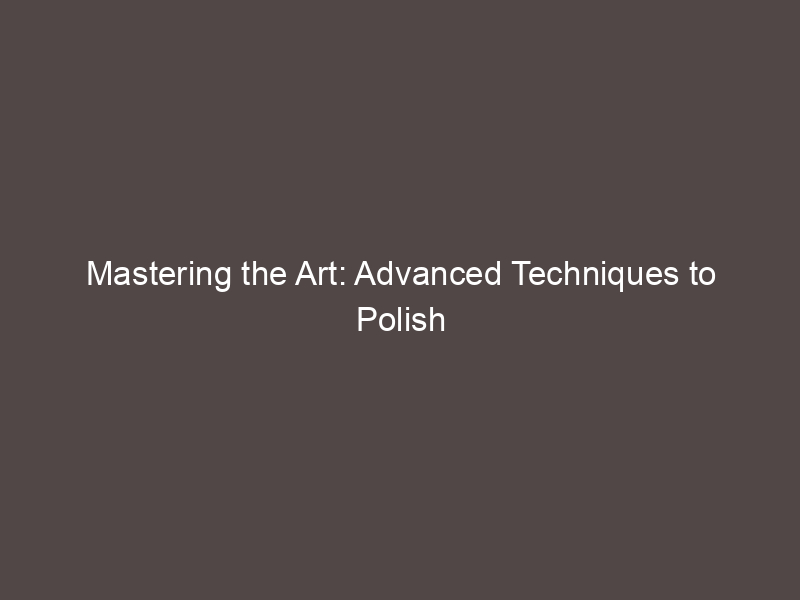
Introduction to Advanced Finishing Techniques
Finishing a project is more than just reaching the end. It’s about giving your work that final touch, that extra shine that makes it stand out. In this section, we will introduce you to advanced finishing techniques that will take your projects to the next level.
- Understanding the basics of project polishing
- Why polishing techniques matter in project finishing
Project polishing is the final step in any project. It’s the process of refining and perfecting your work, making it as good as it can possibly be. This can involve a variety of techniques, from sanding and buffing to applying a final coat of paint or varnish. The goal is to make your project look professional and high-quality.
Polishing techniques are crucial in project finishing because they can dramatically improve the look and feel of your work. A well-polished project not only looks better, but it also feels better to the touch, and can even last longer. For example, a wooden table that has been properly sanded and varnished will be smoother, more resistant to scratches, and will retain its shine for a longer period of time.
Advanced finishing techniques can seem daunting at first, but with a little practice, they can become second nature. Remember, the key to a successful project is not just in the creation, but in the finishing. So, take the time to learn these techniques, and give your projects the polish they deserve.
Professional Finishing Techniques for DIY Projects
When it comes to DIY projects, the finish can make all the difference. A professional finish not only enhances the look of your project but also increases its longevity. Let’s explore how project polishing plays a key role in achieving a professional finish.
Project Polishing: The Key to a Professional Finish
Project polishing is a crucial step in the finishing process. It involves smoothing and refining the surface of your project to give it a polished, professional look. The right tools and technique are essential for successful project polishing. Let’s delve into the details.
- Choosing the Right Tools for Polishing
- Step-by-Step Guide to Project Polishing
Choosing the right tools is the first step towards achieving a professional finish. For wood projects, sandpaper with different grits is essential. For metal projects, you may need a buffing wheel and polishing compounds. Always remember, the right tool can make your polishing process easier and more effective.
Once you have the right tools, follow these steps to polish your project:
| Step | Description |
|---|---|
| 1 | Start with a rough grit sandpaper and sand the entire surface of your project. |
| 2 | Gradually move to finer grit sandpaper, ensuring to remove all scratches from the previous grit. |
| 3 | Once the surface is smooth, apply a coat of your chosen finish. |
| 4 | Let the finish dry completely, then lightly sand the surface with a very fine grit sandpaper. |
| 5 | Apply a second coat of finish, let it dry, and then polish the surface to a high shine. |
Remember, patience and attention to detail are key in achieving a professional finish.
Advanced Polishing Methods
Polishing is a crucial step in any DIY project. It not only enhances the appearance of your project but also protects it. Let’s delve deeper into some advanced polishing methods that can take your DIY projects to the next level.
- Exploring Different Polishing Techniques
- Case Study: How Advanced Polishing Methods Transformed a DIY Project
There are numerous polishing techniques that you can use depending on the type of material and the desired finish. Here are a few:
| Technique | Description |
|---|---|
| Buff Polishing | This method uses a buffing wheel and compound to smooth the surface. It’s perfect for metals and plastics. |
| Vibratory Polishing | This technique uses a machine to vibrate the project in a tub of polishing media. It’s great for small, intricate parts. |
| Hand Polishing | This is the traditional method where you use a cloth and polishing compound. It’s ideal for delicate or complex projects. |
Let’s look at a real-life example of how advanced polishing methods can make a difference. John, a DIY enthusiast, was working on a wooden coffee table. Initially, he used basic hand polishing. However, the result was not as shiny as he wanted.
Then, he decided to try buff polishing. He bought a buffing wheel and compound. After a few hours of work, the table’s surface transformed. It was smooth, shiny, and looked professional. This case study shows how exploring and applying advanced polishing methods can dramatically improve the outcome of your DIY projects.
Techniques for Polishing: Beyond the Basics
Polishing is a crucial step in any project. It’s the final touch that can make or break the overall look and feel of your work. But polishing is more than just a quick wipe down. It requires specific techniques and a keen eye for detail. Let’s delve into some advanced polishing techniques that can take your project to the next level.
Project Finishing Tips: Polishing Techniques
Whether you’re a DIY enthusiast or a professional, these tips can help you avoid common mistakes and learn from the best in the business.
- Common mistakes to avoid in project polishing
- Key takeaways from professional project finishers
One common mistake is rushing through the polishing process. It’s important to take your time and pay attention to detail. Another mistake is using the wrong tools or materials for polishing. Always ensure you have the right equipment for the job. Lastly, many people forget to clean their project before polishing. This can lead to a dull finish and even damage the project.
Professionals know that polishing is an art. They understand the importance of patience and precision. They also know that each project is unique and requires a tailored approach. One key takeaway from professionals is to always test your polishing technique on a small, hidden area first. This way, you can ensure the technique works well with your project material without causing any visible damage.
In conclusion, polishing is a vital step in project finishing. By avoiding common mistakes and learning from professionals, you can enhance the quality of your projects and achieve a professional finish. Remember, practice makes perfect. So, don’t be afraid to experiment with different techniques and tools to find what works best for you.
Advanced Techniques for Project Finishing
When it comes to finishing your projects, there’s always room for improvement. The world of project finishing is vast and full of advanced techniques that can take your work from good to great. Let’s dive into these techniques and see how they can transform your projects.
- How to apply advanced finishing techniques in your projects
- Plan Ahead: Before you start, have a clear idea of what you want your finished project to look like. This will guide your choice of techniques.
- Choose the Right Tools: Different techniques require different tools. Make sure you have the right ones for the job.
- Practice: Don’t be afraid to practice a technique before applying it to your project. This can save you from costly mistakes.
- Patience: Advanced techniques often require time and patience. Don’t rush the process.
- Examples of projects transformed by advanced finishing techniques
Applying advanced finishing techniques is not as daunting as it may seem. It’s all about the details. Here are some steps to guide you:
Advanced finishing techniques can make a world of difference in your projects. Here are a few examples:
| Project | Before Advanced Techniques | After Advanced Techniques |
|---|---|---|
| Wooden Chair | Plain, unvarnished, rough edges | Smooth, glossy finish, rounded edges |
| Handmade Quilt | Loose threads, uneven stitching | Tight stitches, clean edges, intricate patterns |
| Painted Canvas | Flat colors, no texture | Rich colors, varied textures, detailed brushwork |
As you can see, advanced finishing techniques can elevate your projects to a whole new level. So, don’t be afraid to learn and apply these techniques. Remember, practice makes perfect!
Mastering the Art of Project Polishing
Project polishing is an essential skill that can elevate your work from good to great. It’s all about the details, and mastering this art can make a significant difference in your projects. Let’s embark on a journey from being a novice to becoming an expert in project polishing.
From Novice to Expert: Your Journey in Project Polishing
Transitioning from a novice to an expert in project polishing involves two key steps: developing a consistent project polishing routine and continuously improving your polishing techniques.
- Developing a consistent project polishing routine
- How to continuously improve your polishing techniques
Consistency is key when it comes to project polishing. Developing a routine can help you ensure that no detail is overlooked. Start by setting aside a specific time each day for polishing your projects. This could be in the morning when you’re fresh and alert, or in the evening when you can review the day’s work. Make sure to stick to this routine, as it will help you build a habit of meticulousness and attention to detail.
Improvement is a continuous process. Always be on the lookout for new techniques and methods to polish your projects. This could involve reading up on the latest trends, attending workshops, or even learning from your peers. Remember, the goal is to constantly improve and refine your skills.
In conclusion, mastering the art of project polishing involves developing a consistent routine and continuously improving your techniques. With patience and practice, you can elevate your projects and stand out in your field.
Conclusion: The Impact of Advanced Finishing Techniques
As we conclude our exploration of advanced finishing techniques, it’s essential to reflect on the importance of project polishing and look forward to the future trends in this field.
- Reflecting on the Importance of Project Polishing
- Future Trends in Advanced Finishing Techniques
Project polishing is more than just the final touch on a project. It’s the difference between a good project and a great one. It’s the attention to detail that transforms a simple DIY project into a professional-level masterpiece. The use of advanced finishing techniques can significantly enhance the appearance, durability, and value of a project. It’s like the icing on a cake, making it not only delicious but also visually appealing.
As we look to the future, advanced finishing techniques continue to evolve and improve. With the rise of technology, we can expect to see more automated and precision-based techniques. These will not only make the process more efficient but also provide a higher quality finish. For example, the use of 3D printing in project finishing is already on the rise, allowing for more intricate and detailed finishes. Similarly, the use of eco-friendly materials and techniques is also expected to become more prevalent, reflecting the increasing global emphasis on sustainability.
In conclusion, mastering advanced finishing techniques is not just about improving your DIY projects. It’s about understanding the value of a well-finished project and staying updated with the latest trends in the field. So, keep polishing your skills and continue to create beautiful, high-quality projects.






